You’ll discover that fast-growing houseplants offer a practical solution for transforming empty spaces into lush, green environments within weeks. These rapid growers, which can add 6-12 inches of growth per month under ideal conditions, range from trailing vines to upright statement pieces. While some popular varieties like Spider Plants and Pothos thrive in most indoor settings, others bring unique features: variegated leaves, aerial roots, or cascading stems; each offers distinct advantages for specific lighting situations and care requirements.

Contents
1. Spider Plant
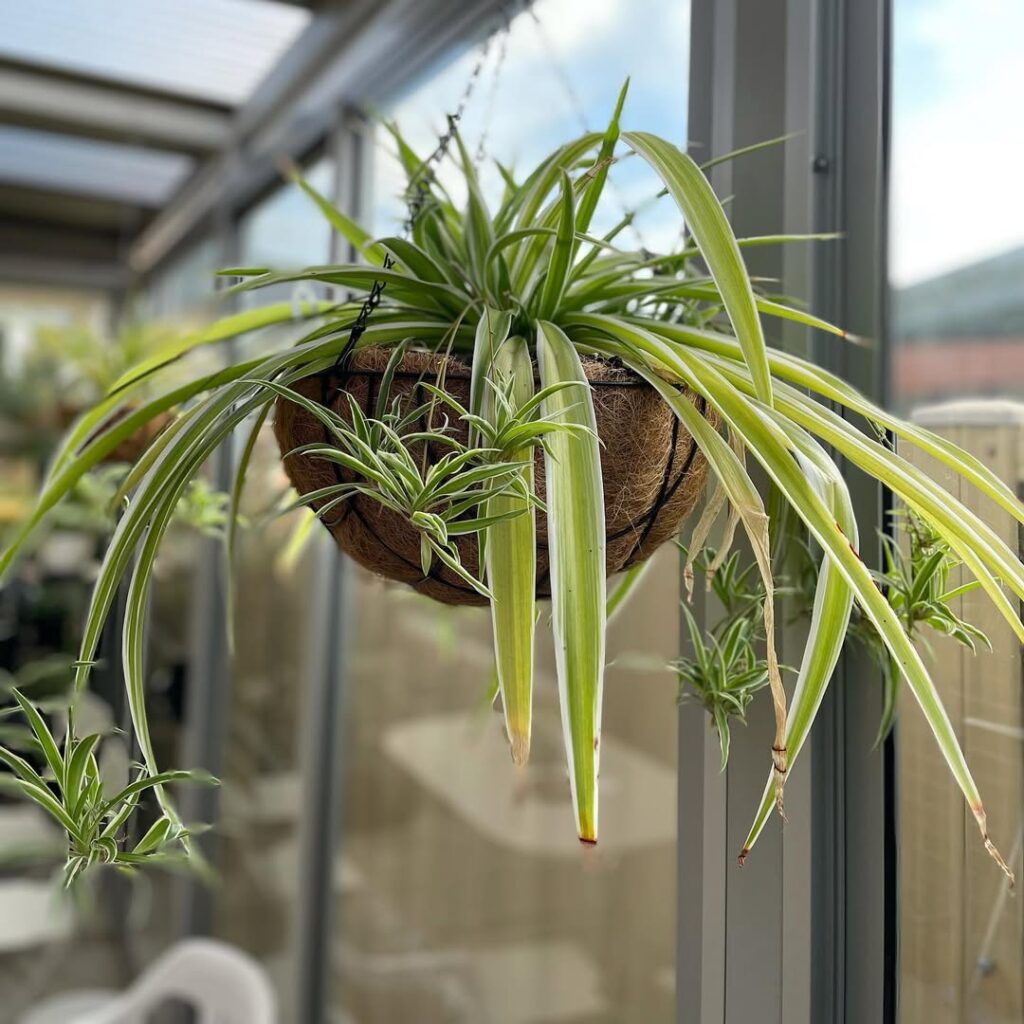
Spider plants (Chlorophytum comosum) are among the fastest-growing houseplants, capable of producing long arching stems with baby plantlets within weeks under ideal conditions. These resilient plants can quickly fill out a hanging basket or container with their cascading foliage, creating a full, dramatic display. The distinctive green and white striped leaves grow rapidly from the center of the plant, while the spiderettes that develop at the ends of long stems can be easily propagated to create new plants.
- Light: Bright indirect light; can tolerate moderate light but avoid direct sun
- Water: Keep soil consistently moist but not soggy; water when top inch of soil feels dry
- Soil: Well-draining potting mix rich in organic matter
- Temperature: 60-75°F (15-24°C)
- Humidity: Average household humidity; tolerates dry air
- Fertilizer: Feed monthly with balanced liquid fertilizer during growing season
- Container: Well-draining pot with drainage holes
- Spacing: Plant will spread 2-3 feet when mature
2. Pothos
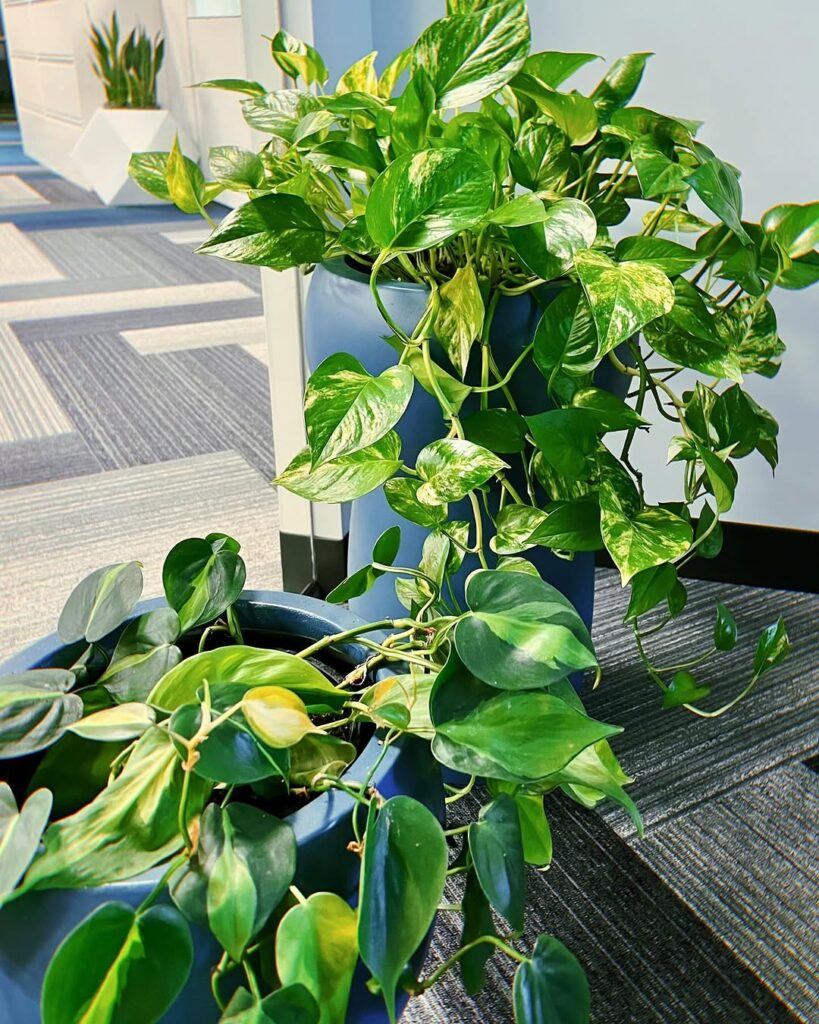
Pothos (Epipremnum aureum) is one of the fastest-growing and most adaptable houseplants available, capable of producing long trailing vines with heart-shaped leaves in various patterns of green, yellow, and white. This vigorous grower can extend multiple feet per year when provided with ideal conditions, making it an excellent choice for hanging baskets, climbing poles, or cascading from high shelves.
- Light: Tolerates low to bright indirect light; avoid direct sunlight; variegated varieties need brighter light to maintain patterns
- Water: Allow top 1-2 inches of soil to dry between waterings; more frequent in bright light, less in low light
- Soil: Well-draining potting mix; prefers slightly acidic pH 6.1-6.5
- Humidity: Adaptable to average indoor humidity levels; benefits from occasional misting
- Temperature: Thrives in normal room temperatures between 60-80°F (15-27°C)
- Fertilizer: Feed monthly during growing season with balanced liquid fertilizer diluted to half strength
3. Philodendron Brasil

Philodendron Brasil is a vigorous climbing vine known for its heart-shaped leaves featuring vibrant lime-green variegation along dark green foliage. This tropical plant can grow up to 1-2 feet per year in ideal conditions, making it an excellent choice for those seeking rapid growth. The vining stems can reach lengths of 10-20 feet, and the plant’s trailing nature makes it perfect for hanging baskets or climbing up moss poles.
- Light: Bright, indirect light; avoid direct sunlight which can burn leaves
- Water: Allow top 1-2 inches of soil to dry between waterings; water less in winter
- Soil: Well-draining, rich potting mix with organic matter
- Humidity: Prefers 60-70% humidity; mist regularly or use a humidity tray
- Temperature: 65-80°F (18-27°C)
- Fertilizer: Monthly feeding with balanced liquid fertilizer during growing season
- Support: Provide moss pole or trellis for climbing
- Pruning: Trim regularly to control growth and promote bushiness
4. Swiss Cheese Plant
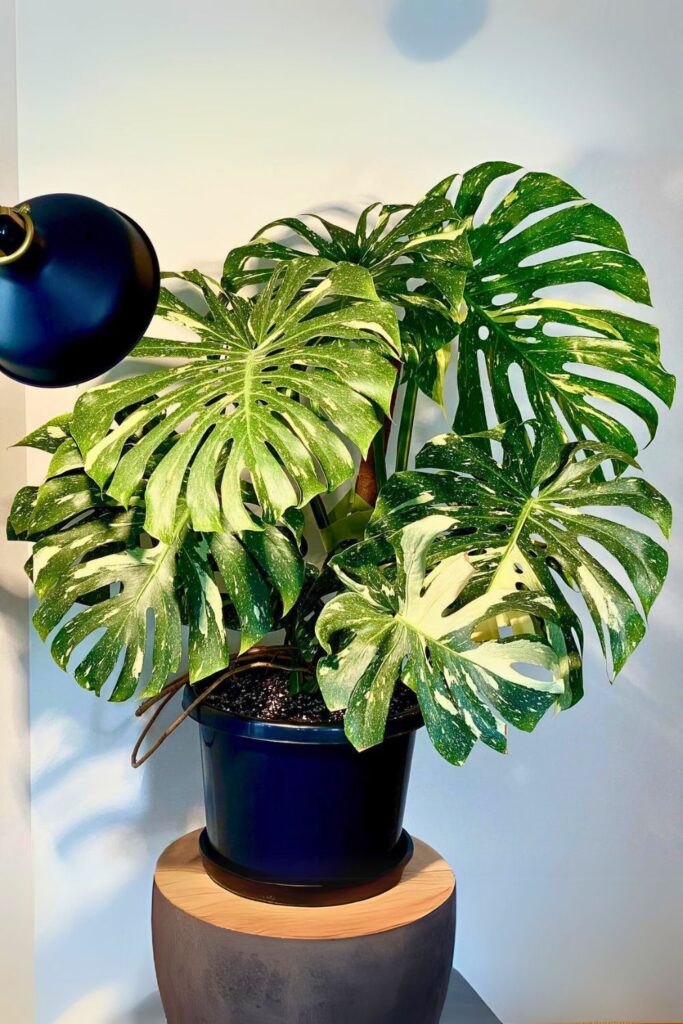
The Swiss Cheese Plant (Monstera deliciosa) is a rapid-growing tropical vine known for its distinctive perforated leaves that develop unique splits and holes as they mature. This popular houseplant can grow several feet tall annually when given ideal conditions, with individual leaves reaching up to two feet wide. The plant’s fast growth rate and dramatic appearance make it an excellent choice for creating bold interior statements quickly, though it requires adequate space to accommodate its vigorous expansion.
- Light: Bright indirect light; avoid direct sunlight which can burn leaves
- Water: Keep soil consistently moist but not waterlogged; water when top 1-2 inches of soil feels dry
- Soil: Well-draining, rich potting mix with added peat moss and perlite
- Humidity: High humidity (60-80%); regular misting or humidifier recommended
- Temperature: 65-80°F (18-27°C)
- Support: Moss pole or trellis for climbing
- Fertilizer: Monthly feeding during growing season with balanced liquid fertilizer
- Pot Size: Large container with drainage holes; repot annually as plant grows
5. Umbrella Plant
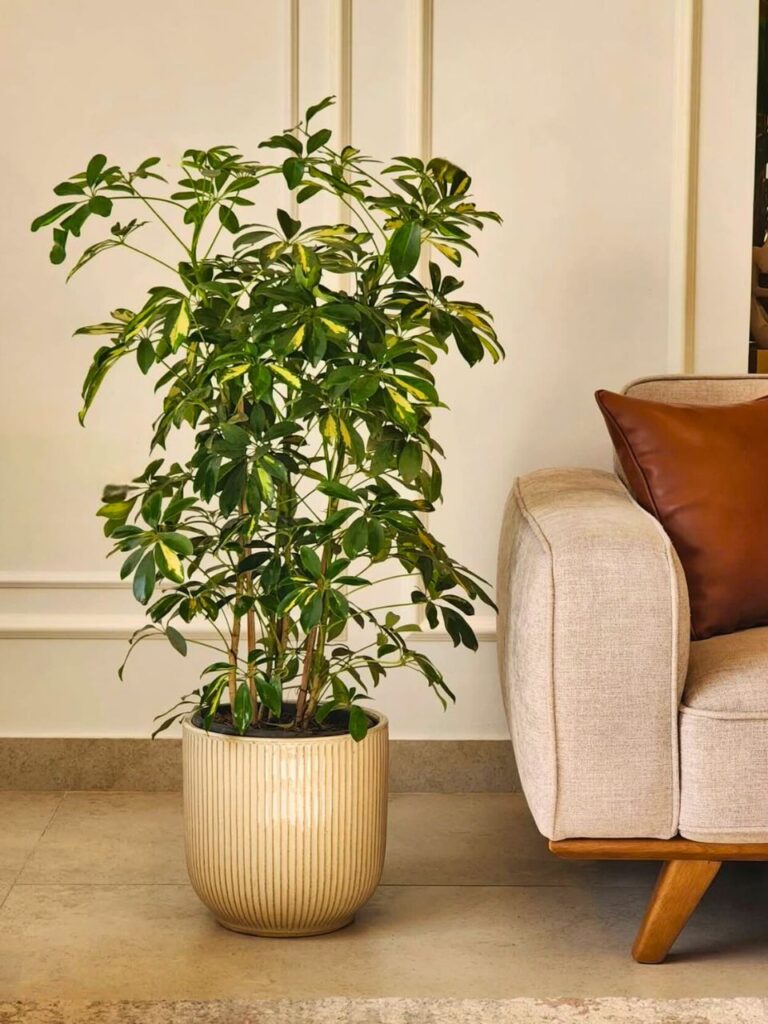
The umbrella plant (Schefflera arboricola) is a rapid-growing tropical houseplant that can spread markedly in ideal conditions, reaching heights of 4-8 feet indoors. Its distinctive palm-like foliage features leaflets arranged in an umbrella formation, and the plant readily branches out to create a full, bushy appearance. When given proper care, umbrella plants can grow up to 12 inches per year, making them an excellent choice for quickly filling empty spaces in a home.
- Light: Bright, indirect sunlight; can tolerate some direct morning sun but avoid harsh afternoon light
- Water: Allow top inch of soil to dry between waterings; reduce watering in winter
- Soil: Well-draining, rich potting mix with added perlite
- Humidity: Moderate to high; benefits from regular misting
- Temperature: 65-80°F (18-27°C)
- Fertilizer: Feed monthly during growing season with balanced liquid fertilizer
- Pruning: Regular trimming encourages bushier growth and controls spread
- Repotting: Every 2-3 years as plant outgrows container
6. English Ivy
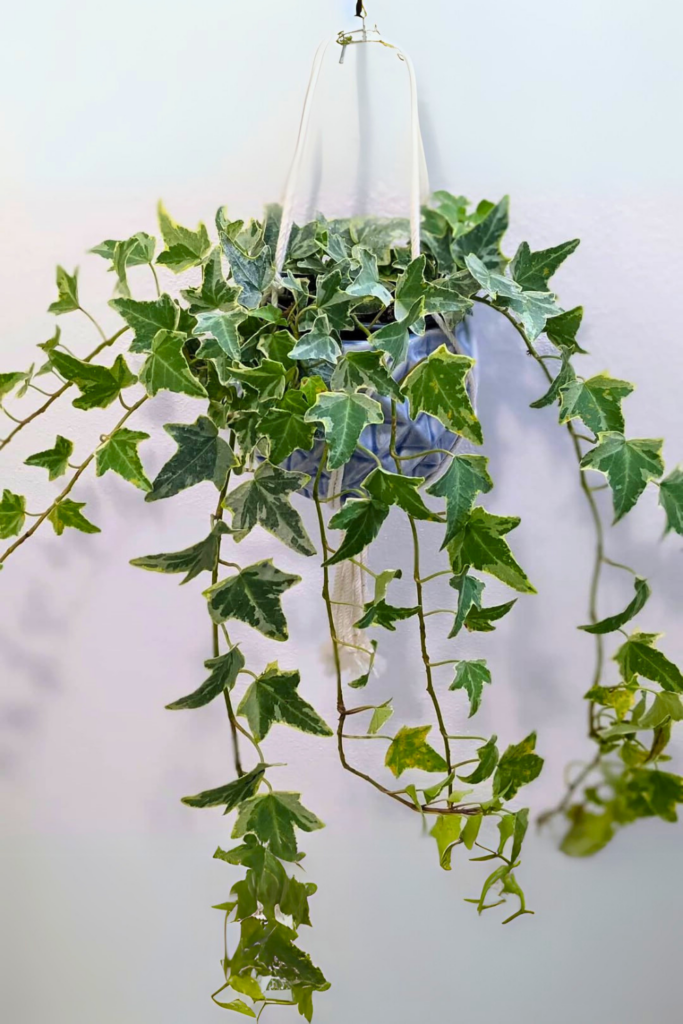
English Ivy (Hedera helix) is a vigorous climbing vine known for its rapid growth rate of up to 9 feet per year when provided ideal conditions. Its distinctive lobed leaves create an elegant cascading effect as the plant climbs walls, trellises, or spreads as ground cover. The plant’s aggressive growth habit and ability to attach to surfaces through aerial rootlets make it an excellent choice for quickly covering bare walls or creating living screens, though careful monitoring is needed to prevent it from becoming invasive.
- Light: Bright indirect light indoors; tolerates partial to full shade
- Water: Keep soil consistently moist but not waterlogged; water when top inch of soil feels dry
- Soil: Well-draining, slightly acidic potting mix rich in organic matter
- Humidity: Prefers moderate to high humidity; mist leaves regularly
- Temperature: 50-70°F (10-21°C)
- Fertilizer: Feed monthly during growing season with balanced liquid fertilizer
- Support: Provide trellis, moss pole, or similar structure for climbing
7. Chinese Evergreen
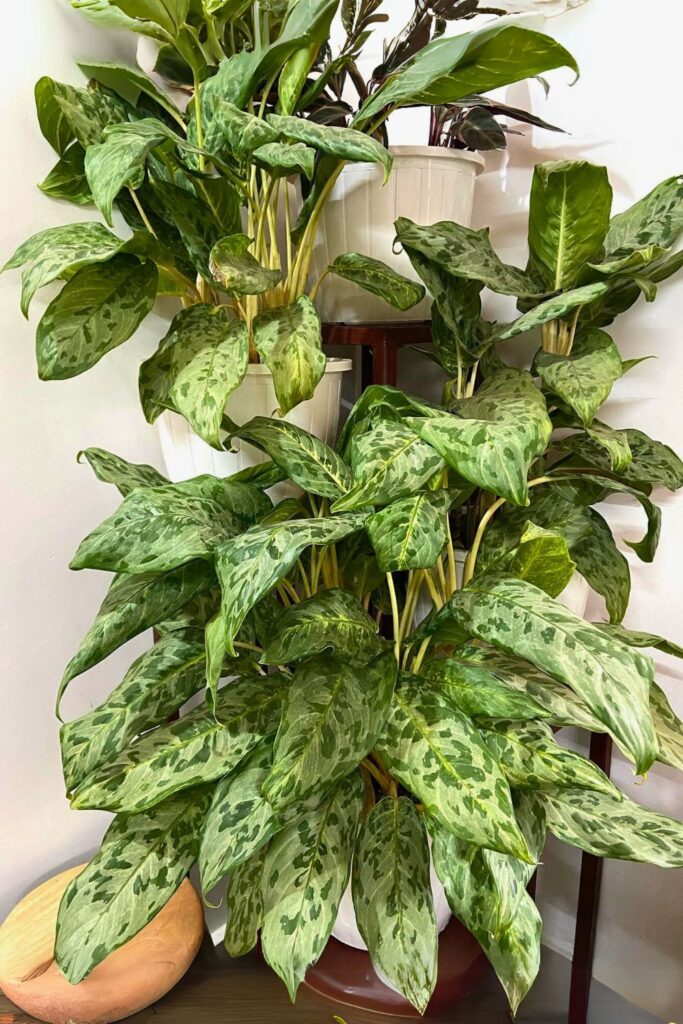
The Chinese Evergreen (Aglaonema) is a fast-growing tropical plant known for its attractive, variegated foliage and adaptability to indoor conditions. Its leaves feature various patterns of green, silver, and sometimes pink or red, making it an excellent choice for adding visual interest to any room. This hardy plant can grow up to 3 feet tall and spreads readily through natural stem division, allowing gardeners to easily propagate new plants from a single specimen.
- Light: Tolerates low to moderate light; avoid direct sunlight; thrives in filtered or indirect light
- Water: Keep soil consistently moist but not waterlogged; water when top inch of soil feels dry
- Soil: Well-draining potting mix rich in organic matter
- Temperature: Prefers warm environments between 65-80°F (18-27°C)
- Humidity: Enjoys high humidity; mist leaves regularly or use a humidity tray
- Fertilizer: Feed monthly during growing season with balanced liquid fertilizer
- Pot: Use containers with drainage holes to prevent root rot
- Toxicity: Keep away from pets and children as leaves are toxic if ingested
8. Wandering Jew
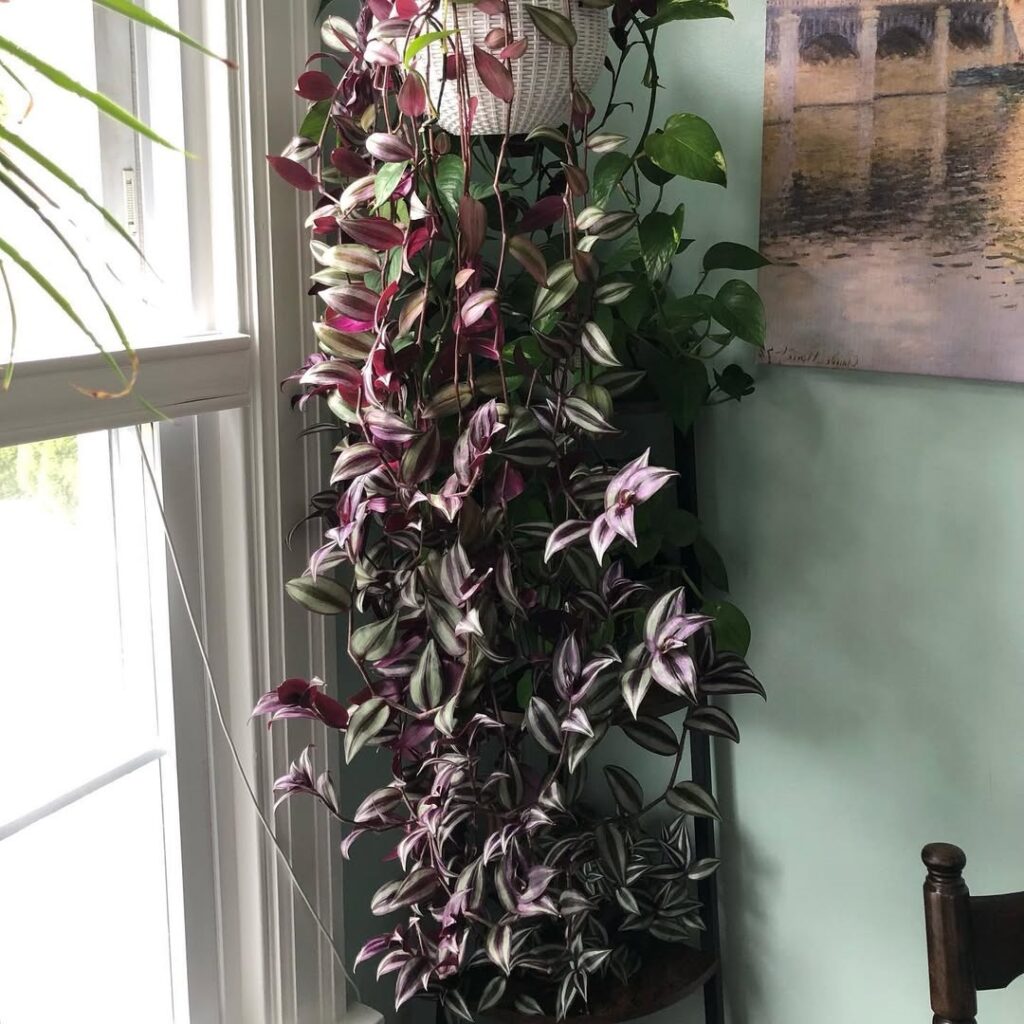
The Wandering Jew plant (Tradescantia zebrina) is a fast-growing, trailing houseplant known for its striking purple and silver striped leaves. This versatile plant produces long, sprawling stems that can cascade from hanging baskets or spread as attractive groundcover. The succulent-like stems root easily where they touch soil, making it simple to propagate and maintain a full, lush appearance. Its vibrant foliage and rapid growth rate make it a popular choice for indoor gardening.
- Light: Bright to moderate indirect light; protect from harsh direct sunlight
- Water: Keep soil consistently moist but not waterlogged; water when top inch of soil feels dry
- Soil: Well-draining potting mix rich in organic matter
- Humidity: Prefers moderate to high humidity; mist leaves regularly
- Temperature: 60-80°F (15-27°C)
- Fertilizer: Feed monthly during growing season with balanced liquid fertilizer
- Container: Use pots with drainage holes; hanging baskets or containers that allow trailing
9. Rubber Plant
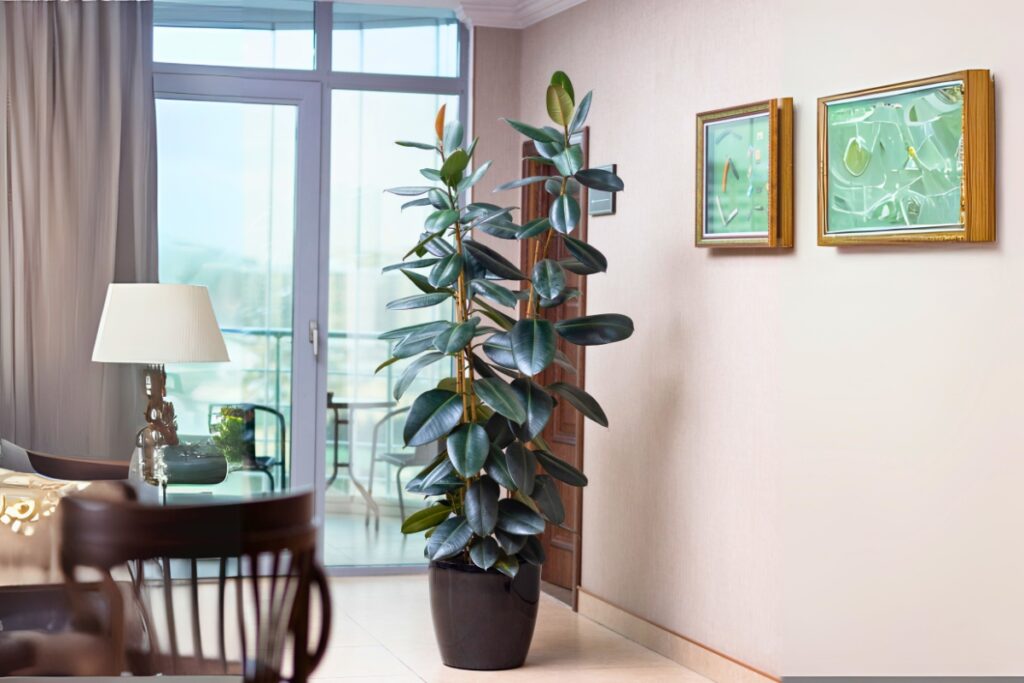
The Rubber Plant (Ficus elastica) is known for its impressive growth rate, capable of adding several feet in height annually under ideal conditions. Its large, glossy leaves and sturdy stems make it an attractive choice for indoor spaces, and its rapid vertical growth can quickly fill empty corners or create dramatic focal points. When well-maintained, this tropical plant can reach ceiling heights indoors while developing a full, bushy appearance.
- Light: Bright, indirect light; can tolerate some direct morning sun but avoid harsh afternoon sunlight
- Water: Allow top inch of soil to dry between waterings; reduce watering in winter
- Soil: Well-draining, rich potting mix with good aeration
- Temperature: 60-80°F (15-27°C)
- Humidity: 40-60%; benefits from regular misting
- Fertilizer: Feed monthly during growing season with balanced liquid fertilizer
- Pot Size: Repot annually while young into container 2 inches larger than previous
10. Tradescantia
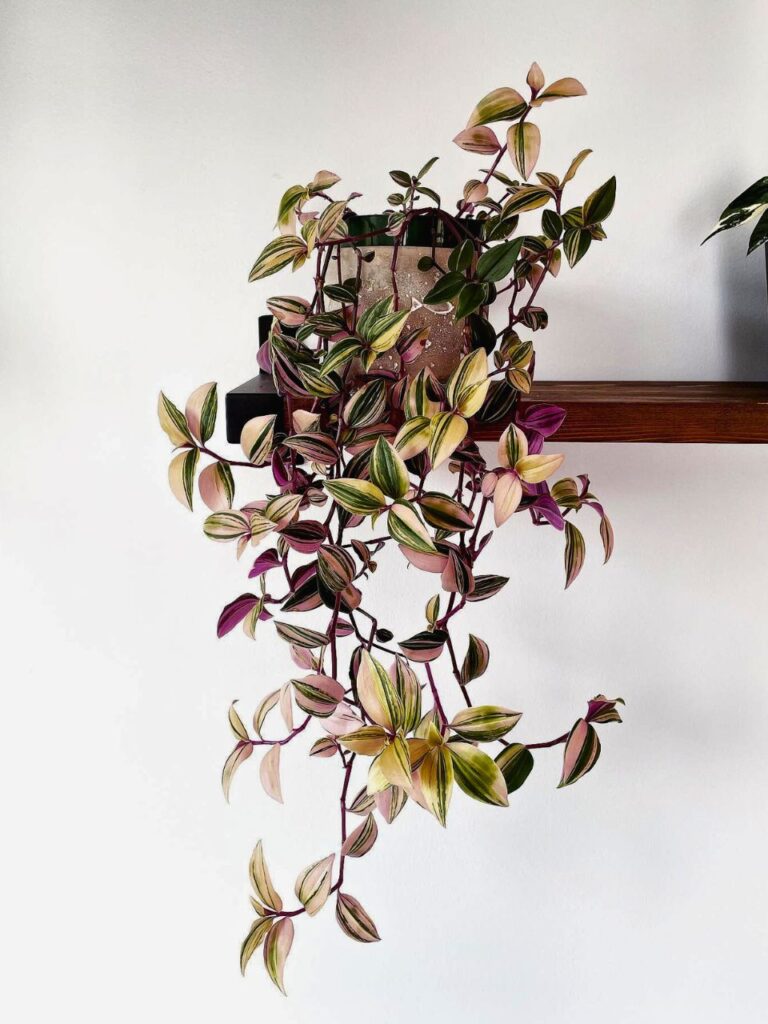
Tradescantia, also known as inch plant, is a fast-growing trailing houseplant that can add up to 6-8 inches of growth per month in ideal conditions. Its vibrant, striped leaves come in various colors including purple, green, silver, and pink, making it a popular choice for hanging baskets or as a cascading accent plant. The stems can grow up to 2-3 feet long, and the plant’s aggressive growth rate means it can quickly fill out spaces and create stunning displays.
- Light: Bright, indirect light; can tolerate some direct morning sun but protect from harsh afternoon sunlight
- Water: Keep soil consistently moist but not waterlogged; water when top inch of soil feels dry
- Soil: Well-draining potting mix rich in organic matter
- Humidity: Moderate to high humidity; mist regularly in dry conditions
- Temperature: 60-80°F (15-27°C)
- Fertilizer: Feed monthly during growing season with balanced liquid fertilizer
- Pruning: Regular trimming encourages bushier growth and prevents legginess
- Container: Use pots with drainage holes to prevent root rot
11. Snake Plant

Snake Plants (Sansevieria) are robust, upright-growing succulents that can add up to 2-4 new leaves per growth cycle, with mature leaves reaching heights of 2-4 feet in ideal conditions. Their fast vertical growth and ability to produce new shoots from their rhizomes make them one of the quickest-growing indoor plants, especially during the spring and summer months when growth is most active.
- Light: Tolerates low light but grows fastest in bright, indirect light; can handle some direct sun
- Water: Allow soil to dry completely between waterings; water every 2-4 weeks
- Soil: Well-draining potting mix; preferably cactus or succulent blend
- Temperature: 60-85°F (15-29°C)
- Humidity: Adaptable to any humidity level
- Fertilizer: Light feeding with balanced fertilizer every 2-3 months during growing season
- Container: Pot with drainage holes; slightly root-bound conditions encourage growth
12. Boston Fern
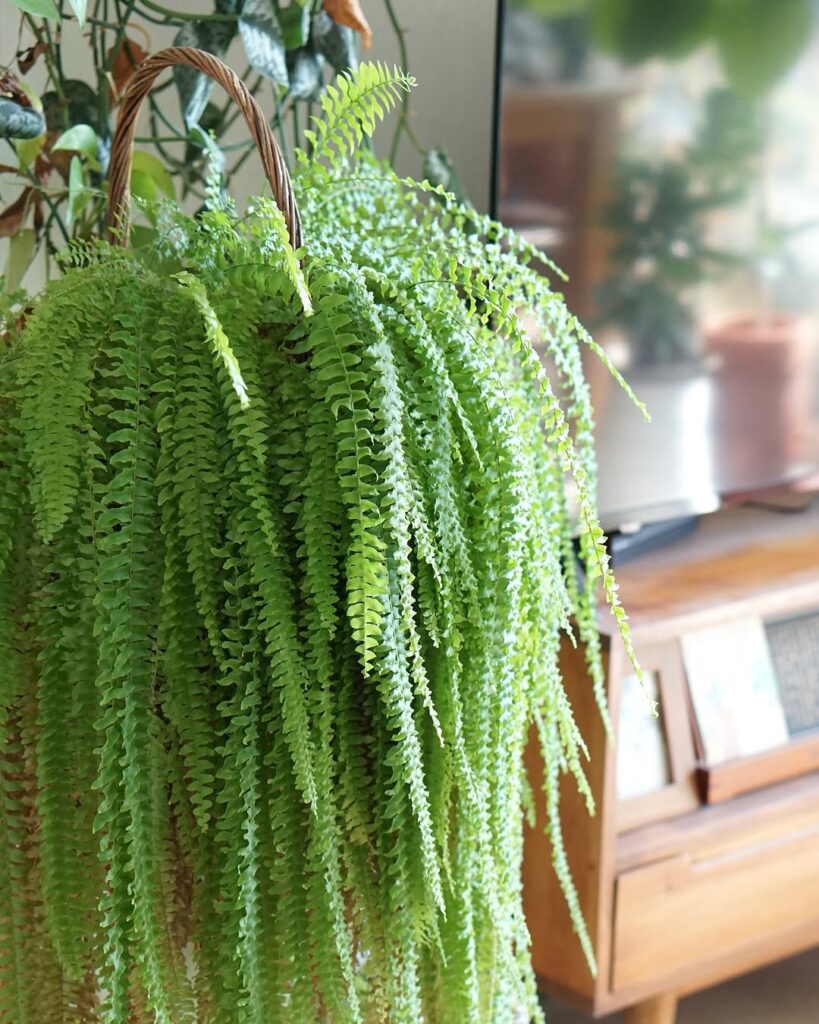
The Boston Fern (Nephrolepis exaltata) is renowned for its rapid growth rate and cascading fronds that can unfurl at an impressive pace, especially during the growing season. As new fronds emerge from the center of the plant, they quickly develop from tight coils into graceful, arching leaves that can reach lengths of up to 3 feet, creating a lush, fountain-like appearance. This vigorous growth pattern makes it an excellent choice for hanging baskets or elevated planters where the fronds can dramatically spill over the edges.
- Light: Bright, indirect light; avoid direct sunlight which can scorch the fronds
- Water: Keep soil consistently moist but not waterlogged; mist regularly to maintain humidity
- Soil: Well-draining, rich potting mix with high organic content
- Temperature: 60-75°F (16-24°C)
- Humidity: High humidity levels (50% or higher)
- Fertilizer: Feed monthly with balanced, water-soluble fertilizer during growing season
- Container: Use pot with adequate drainage holes
- Space: Allow room for spread as fronds can extend 2-3 feet
13. Lucky Bamboo
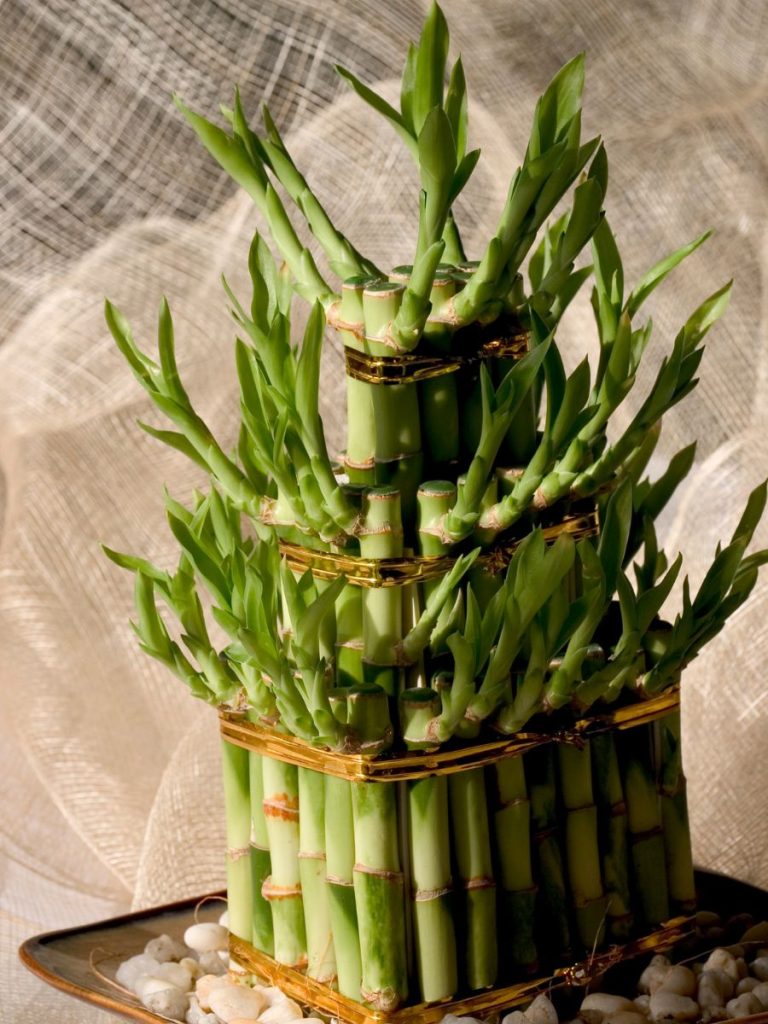
Lucky bamboo clusters are popular indoor plants that can grow rapidly under the right conditions, reaching heights of 1-3 feet within months. Despite its name, it’s not actually bamboo but rather Dracaena sanderiana, a member of the Asparagaceae family. These plants are often sold in decorative arrangements with multiple stalks twisted or braided together, and they can produce new shoots and leaves quickly when properly maintained, creating fuller, bushier clusters over time.
- Light: Bright, indirect light; avoid direct sunlight which can burn leaves
- Water: Clean, filtered water; keep stems submerged if growing in water, or maintain consistently moist soil
- Temperature: 65-95°F (18-35°C)
- Humidity: Medium to high; thrives in humid environments
- Soil: Well-draining potting mix if planted in soil; can also grow in water with pebbles for support
- Fertilizer: Diluted liquid fertilizer every 2-3 months
- Container: Clear glass container for water growth, or pot with drainage for soil
- pH: 6.0-6.5 for ideal growth
14. ZZ Plant

The ZZ Plant (Zamioculcas zamiifolia) is a rapid-spreading houseplant that multiplies through underground rhizomes, producing new stems and leaves as it grows. While not the fastest-growing indoor plant, its spreading habit allows it to fill out a pot relatively quickly, with new shoots emerging from the soil as the rhizomes expand. The plant’s growth typically occurs in spurts, with new stems developing to full size within a few weeks before entering a resting period.
- Light: Tolerates low to bright indirect light; avoid direct sunlight
- Water: Allow soil to dry between waterings; water sparingly every 2-3 weeks
- Soil: Well-draining potting mix with added perlite
- Temperature: 65-85°F (18-29°C)
- Humidity: Adapts to average indoor humidity levels
- Fertilizer: Light feeding every 3-4 months during growing season
- Potting: Prefers to be slightly root-bound; repot every 2-3 years
- Soil pH: 6.0-7.0
15. String of Hearts
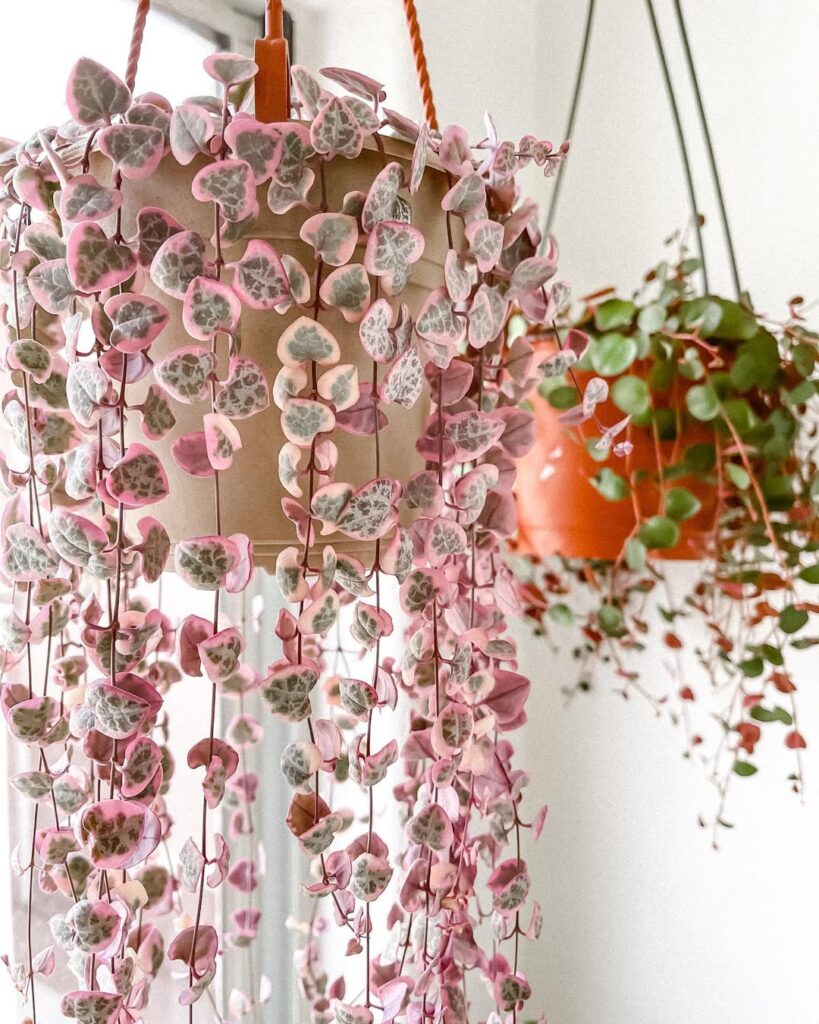
String of Hearts (Ceropegia woodii) is a fast-growing trailing succulent with delicate, heart-shaped leaves that cascade down from hanging baskets or tall containers. Its slender purple stems can grow several feet long in a single growing season, adorned with small, variegated leaves featuring silver marbling on dark green surfaces. The plant produces unique, tubular purple flowers that resemble tiny lanterns, adding to its ornamental appeal.
- Light: Bright, indirect light; can tolerate some direct morning sun
- Water: Allow soil to dry between waterings; water sparingly in winter
- Soil: Well-draining succulent mix or regular potting soil mixed with perlite
- Temperature: 65-80°F (18-27°C)
- Humidity: Tolerates average household humidity
- Fertilizer: Feed with diluted houseplant fertilizer monthly during growing season
- Container: Hanging baskets or elevated pots with drainage holes
- Propagation: Easy to propagate from stem cuttings or tubers
